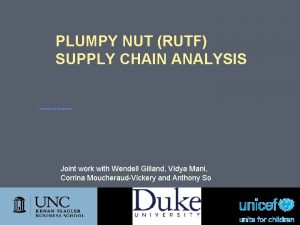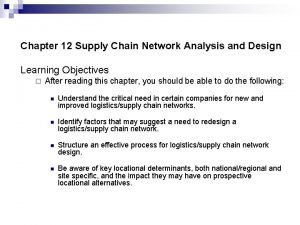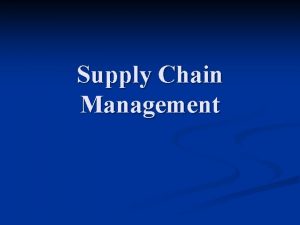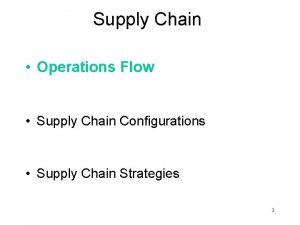PLUMPY NUT RUTF SUPPLY CHAIN ANALYSIS Jayashankar M










- Slides: 10

PLUMPY NUT (RUTF) SUPPLY CHAIN ANALYSIS Jayashankar M. Swaminathan Joint work with Wendell Gilland, Vidya Mani, Corrina Moucheraud-Vickery and Anthony So

Increasing Demand for RUTF (Plumpy Nut) • The recent adoption of guidelines from WHO, WFP, UNSCN and UNICEF that endorse the introduction of these new products to reach severely malnourished children through community-based treatment approaches, • Rising food and fuel prices worldwide that are increasing food insecurity and, consequently, rates of malnutrition; and • A myriad of local circumstances—in Kenya and Somalia these include flooding, droughts and civil unrest—that affect rates of malnutrition. Photo: Brandon Bannon A Joint Statement by the World Health Organization, the World Food Programme, the United Nations System Standing Committee on Nutrition and the United Nations Children’s Fund (2007). Community-based Management of. Severe Acute Malnutrition.

Increasing UNICEF demand for RUTF Table: Steve Jarrett, UNICEF. 2008.

Supply Chain of RUTF UNICEF CO UNICEF ESARO UNICEF SD NGO partners Children Ministry of Health Donors Kenya-specific processes in green Somalia-specific processes in purple RUTF Kuehne + Freight producer Nagel forwarder time PLAN PROCUR PRODUC DELIVER Kenya Somalia Malnourished children Flow of RUTF Flow of information Flow of funds

Supply Chain Challenges Challenge 1: Inefficient flow of information and funds forces supply chain to be reactive, not proactive ¤ Forecasts are inconsistent in methods and quality ¤ Flow of money does not necessarily coincide with need ¤ Causes ordering of RUTF to be uneven

Supply Chain Challenges Challenge 2: Long lead times and high variability across the supply chain ¤ Low production capacity, spikes in ordering and lumpy demand make it hard to achieve consistent lead times ¤ Margin of error compounds at each delivery point in supply chain, making it difficult to project accurate lead times ¤ High variability leads to low trust in the supply chain

Supply Chain Challenges Challenge 3: Mismatch between ordering amount and actual need ¤ Amounts ordered inconsistent with number of children served ¤ Scarcity of supply, uncertainty in targeted arrival dates and limited fund flow make it hard for COs to rely on the supply chain May lead to orders being inflated.

Supply Chain Challenges Challenge 4: Information systems and flows could be improved ¤ Backward information flow, including information on handover and feedback on quality, is either unavailable or nontransparent ¤ Exception handling capabilities not present ¤ Information may be inconsistent

Supply Chain Challenges Challenge 5: The future of RUTF demand is uncertain ¤ RUTF demand will vary depending on level of long term success and with short term spikes in demand due to local crises.

Current and Future Work Recommendation for changes in the current supply chain Articulation guidelines and supply chain analysis UNICEF Plumpy Nut Supply Chain case Analytical models for strategies and insights
 Plumpy nut
Plumpy nut Matching supply and demand in supply chain
Matching supply and demand in supply chain Value chain and supply chain difference
Value chain and supply chain difference Food chain food chain food chain
Food chain food chain food chain Grid technique supply chain
Grid technique supply chain Supply chain management cost analysis
Supply chain management cost analysis Chapter 5 section 1 supply and the law of supply
Chapter 5 section 1 supply and the law of supply Uri ng elastisidad ng supply na may parehong bahagdan
Uri ng elastisidad ng supply na may parehong bahagdan Anecdotal lede examples
Anecdotal lede examples Nut graf examples
Nut graf examples Nut graf
Nut graf



















